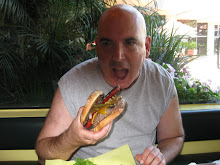Portland, Australia: home of “O homem da guerra.”--written by Christopher Cade (4-7-10)
In 1966, when Bruce Brown was filming his seminal surfing documentary “The Endless Summer,” he came across one of the cleverest types of urban legend that exist in the surfing world today. Everybody knows how ruthless the lineup at Bonzai Pipeline on the North Shore of Oahu or Wind and Sea in San Diego or the best point breaks in Southern California, Malibu and Rincon.
Many people have made their way in to these incredibly competitive lineups and passed on, wherever they were going in their individual lives. However, no story compares with “O homem da guerra,” which came to be something equivalent to a cultish religion throughout the southwestern shore of Australia near Portland in the 1960’s.
The origin of the story, that would ultimately stop people (minus Bruce Brown apparently) from surfing there, tied together two known, but largely insignificant events. First, it was observed that several of the outsiders that were coming there during the best season for waves, around April and May, were plagued by a pretty severe rash and were complaining of a severe pain that accompanied it, usually manifesting itself about 10 to 15 minutes after the rash.
Around the same time, one of the most “epic” surfers of the time, João Maria de Jesus Pires, had come there possessing lightning fast paddling skills, insane cutbacks and above all an incomparable, canine type sense of territory. In effect, he was swimming circles around the local lineup at Queen’s Point, just north of Portland. Formerly a Portuguese-British merchant-shipper, he had met and married his Portland wife Liesel, and had indefinitely relocated himself there, much to the dismay of the locals.
Something had to be done, as Bruce Brown later found out, only after promising that he would never divulge this information in his operational documentary. A local dentist-surfer, Joseph Butler, knew that there was an obvious link to the rash. The out-of-towners were hanging out at the same bar after being in the water all day. The owner of that bar, Nigel Townsend, had a chinchilla in the back. Now chinchillas can be very hairy creatures, carrying some pretty serious allergens among their mop-like physiognomy. These symptoms were consistent with helianthus eschscholzi-raz-c, and through adaptation and classical conditioning, the locals had minimized their undesired encounters with this allergic reaction.
Dr. Butler spoke with one of the venerated surfers of Portland at that time, Miles Landing and the two of them together, concocted a myth that to this day has not been dispelled. Around the horn that jutted off to the South, they knew to exist a certain Armadillo that when laying eggs would coat the nesting area with a highly toxic petroleum jelly/ wax-textured substance. It served two obvious functions: to incubate the eggs and to ward off predators. But when in direct contact with the human epidermis it would produce a rash very similar to the one caused by helianthus eschscholzi.
When mama armadillo ventured off to round up some dinner for her growling underside, Butler and Landing lurched in undetected, carefully collecting a moderate amount of the substance. They then returned to Landing’s surf shop, known simply as Landing’s Inn. They removed all bars of surfing wax from the display case, and began introducing through the plastic wrapper into the core of the product a generous amount of the armadillo jelly.
About a week later, when Maria de Jesus Pires together with the whole lot of other outsiders (who we must remember were now suffering compounding levels of allergic reaction) were well into their completely preventable agonies, they were told that this was a direct link to the menacing jelly-fish, whom the named after the Portuguese intruder’s moniker, “O homem da guerra.”
This species of jelly fish, no more than an urban legend, is now known worldwide as the Portuguese Man O’War. And when the gulf of Mexico current sweeps in between April and May, developing sustained periods of offshore winds together with sizeable waves at Queen’s Point in Portland, Bruce Brown allows a chuckle to escape him—looking back at his happy hour Mai-Tai at Duke’s Bar in Pacific Palisades, California. How do I know about this? Because I was there.
Wednesday, April 7, 2010
Subscribe to:
Post Comments (Atom)

No comments:
Post a Comment